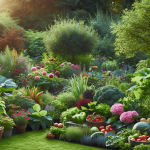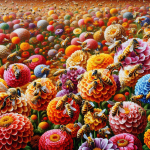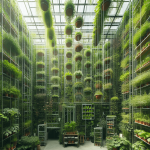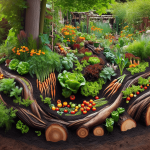This post may contain affiliate links. As an Amazon Associate, we may earn commissions from qualifying purchases.
Designing and Implementing Water-efficient Garden Landscapes in Drought-prone Areas” provides you with essential strategies and creative ideas to transform your garden into a sustainable oasis. In this article, you’ll discover practical tips on selecting drought-resistant plants, using efficient irrigation systems, and enhancing soil health to conserve water. The insights offered will guide you towards creating a beautiful and thriving garden that not only withstands drought conditions but also contributes positively to the environment. Embrace the journey to a greener future with your very own water-efficient landscape. Have you ever wondered how you can maintain a lush and beautiful garden even when you live in a drought-prone area? Gardening in water-scarce regions can be challenging, but with the right planning and techniques, you can create a stunning, drought-resistant landscape that conserves water and thrives in harsh conditions.
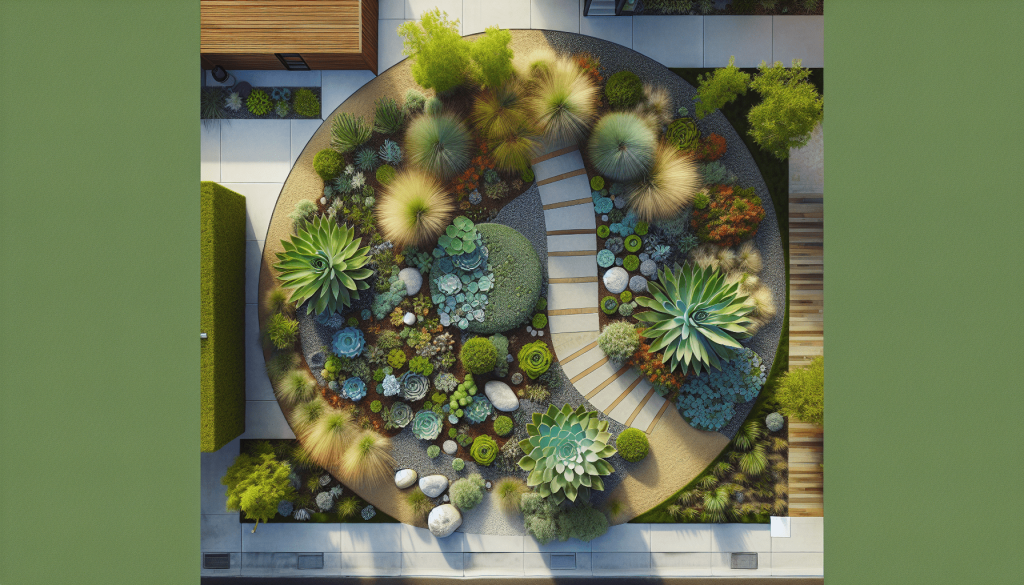
Understanding Your Environment
Before diving into the nitty-gritty of water-efficient garden landscapes, it’s essential to thoroughly understand the environment you’re working with. Note the specific conditions, such as climate, rainfall patterns, soil type, and sun exposure.
Climate and Rainfall Patterns
Drought-prone areas often have inconsistent and scarce rainfall. Familiarize yourself with local climate data to understand the rainfall distribution throughout the year. This will help in selecting appropriate plants and designing efficient irrigation systems.
Soil Type
Soil plays a crucial role in water retention and plant health. Sandy soils drain quickly but don’t hold moisture well, while clay soils retain water but can become waterlogged. Conduct a soil test to determine your soil’s texture and nutrient content. Amendments might be necessary to improve water retention or drainage.
Sun Exposure
Observe the sun patterns in your garden to know which areas receive full sun, partial shade, or full shade. Knowing this will guide your plant selection process, ensuring that you place plants in their ideal growing conditions.
Selecting Water-efficient Plants
Choosing the right plants is the cornerstone of a water-efficient garden. Opt for native and drought-tolerant plants that have adapted to the local climate.
Native Plants
Native plants are often more resilient and require less water than non-native species. They have evolved to thrive in local conditions and can better withstand droughts.
Drought-tolerant Plants
Drought-tolerant plants have special adaptations that allow them to survive with minimal water. Some popular choices include:
| Plant Type | Examples |
|---|---|
| Succulents | Aloe Vera, Sedum, Echeveria, Agave |
| Shrubs | Lavender, Rosemary, Butterfly Bush, Manzanita |
| Grasses | Blue Fescue, Fountain Grass, Feather Reed Grass |
| Trees | Olive, Mesquite, Palo Verde, Eucalyptus |
Grouping Plants by Water Needs
Another effective strategy is to group plants with similar water needs together, also known as hydrozoning. This approach ensures that each zone gets the appropriate amount of water, reducing waste and promoting healthier plant growth.
Efficient Irrigation Systems
Efficient irrigation systems can make a significant difference in water usage. Traditional overhead sprinklers often waste water due to evaporation and runoff. Instead, consider these water-saving irrigation methods:
Drip Irrigation
Drip irrigation systems deliver water directly to the plants’ root zones, minimizing evaporation and runoff. They can be customized to fit any garden layout and are highly efficient.
Soaker Hoses
Soaker hoses are porous and allow water to seep out slowly along their length. They’re an affordable option for watering garden beds and can be buried under mulch for even more effective water delivery.
Smart Irrigation Controllers
Smart irrigation controllers take the guesswork out of watering by adjusting the irrigation schedule based on real-time weather data. These systems ensure your garden gets the right amount of water at the right time.
Mulching for Water Conservation
Mulching is a simple but powerful technique for conserving water in your garden. A layer of mulch helps to retain soil moisture, moderate soil temperature, and reduce weed growth.
Types of Mulch
There are various types of mulch you can use, each with its benefits:
| Type of Mulch | Benefits |
|---|---|
| Organic Mulch | Improves soil structure, adds nutrients |
| Inorganic Mulch | Long-lasting, doesn’t decompose |
| Examples | Bark chips, compost, straw, stones, rubber |
Applying Mulch
Apply a 2-4 inch layer of mulch around your plants, being careful not to pile it up against plant stems. Replenish the mulch as needed to maintain its effectiveness.
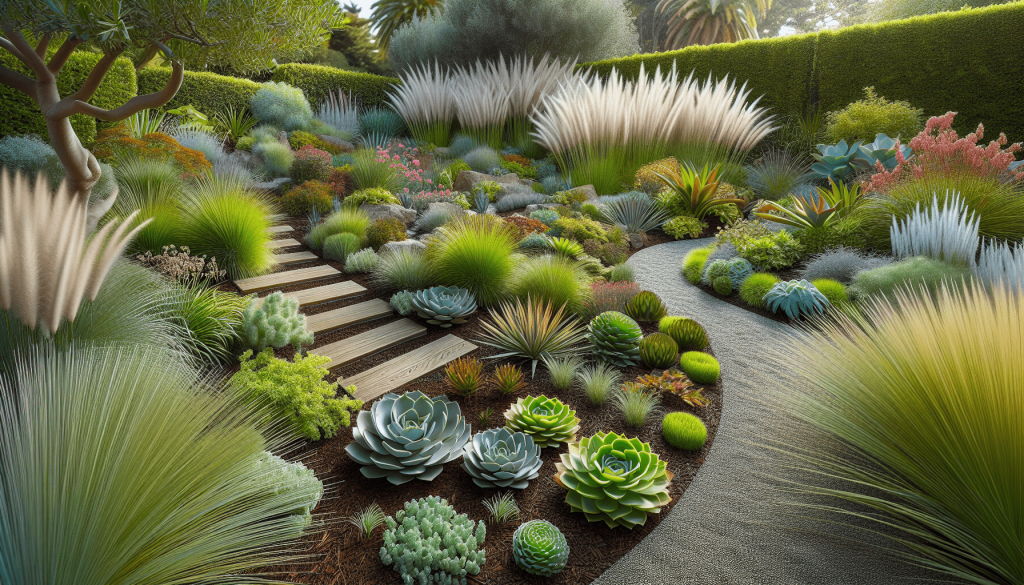
Landscape Design Principles
Thoughtful landscape design can greatly enhance water efficiency in your garden. Consider these principles when planning your garden layout:
Zones of Use
Divide your garden into different zones based on their usage and water requirements. For instance, place high-water-use plants near living areas where you can enjoy them up close, and drought-tolerant plants in remote or less-used areas.
Contouring and Grading
Contour your garden to direct rainwater towards plants and away from hardscapes. Swales, berms, and terraces can help capture and retain rainwater, reducing the need for supplemental irrigation.
Limit Lawn Areas
Lawns require significant water compared to other plants. Consider reducing the size of your lawn or replacing it with drought-tolerant ground covers or other low-water-use plants.
Sustainable Garden Practices
Incorporating sustainable practices into your gardening routine not only saves water but also promotes a healthier ecosystem.
Composting
Composting kitchen scraps and garden waste creates rich, organic matter that improves soil structure and water retention. Use compost as mulch or soil amendment to boost your garden’s health.
Rainwater Harvesting
Collect and store rainwater from your roof using rain barrels or a more extensive rainwater harvesting system. This water can be used for irrigation during dry periods.
Graywater Systems
Graywater systems recycle water from household activities like washing dishes and laundry for garden irrigation. Ensure your system complies with local regulations and uses biodegradable, plant-safe products.
Implementing Your Design
Once you have a solid plan, it’s time to implement your water-efficient garden landscape. Here’s a step-by-step guide to help you get started:
Planning and Preparation
- Sketch Your Garden Layout: Draw a detailed map of your garden, marking different zones and plant locations.
- Test and Amend Soil: Conduct soil tests and incorporate any necessary amendments.
- Install Irrigation Systems: Lay out drip irrigation or soaker hoses according to your plan. Ensure they are properly connected and functional.
Planting Process
- Select Plants: Purchase healthy plants suited to your garden’s conditions.
- Group Plants by Zones: Place plants in their designated hydrozones.
- Prepare Planting Holes: Dig holes slightly larger than the plant’s root ball. Mix compost into the backfill soil.
- Plant and Water: Position plants in the holes, backfill with soil, and water thoroughly.
Final Touches
- Mulch Thoroughly: Apply mulch around all plants, leaving space around the stems.
- Adjust Irrigation Timers: Set your irrigation system to water according to your plants’ needs.
Maintenance Tips
Maintaining a water-efficient garden does require some ongoing effort. Here are some tips to keep your garden thriving:
Monitor and Adjust
Regularly check your irrigation system for leaks, clogs, or other issues. Adjust watering schedules based on seasonal changes and weather conditions.
Prune and Weed
Regularly prune plants to encourage healthy growth and remove weeds that compete for water and nutrients.
Fertilize Appropriately
Use slow-release or organic fertilizers to provide nutrients without overwhelming your plants or contributing to runoff pollution.
Conclusion
Designing and implementing a water-efficient garden landscape in drought-prone areas is not only feasible but also incredibly rewarding. By understanding your environment, choosing the right plants, using efficient irrigation, mulching, and incorporating sustainable practices, you can create a beautiful and resilient garden.
Are you ready to transform your garden into a water-efficient oasis? With a little effort and thoughtful planning, you’ll not only save water but also enjoy a stunning, thriving garden even in the driest of conditions. Happy gardening!

